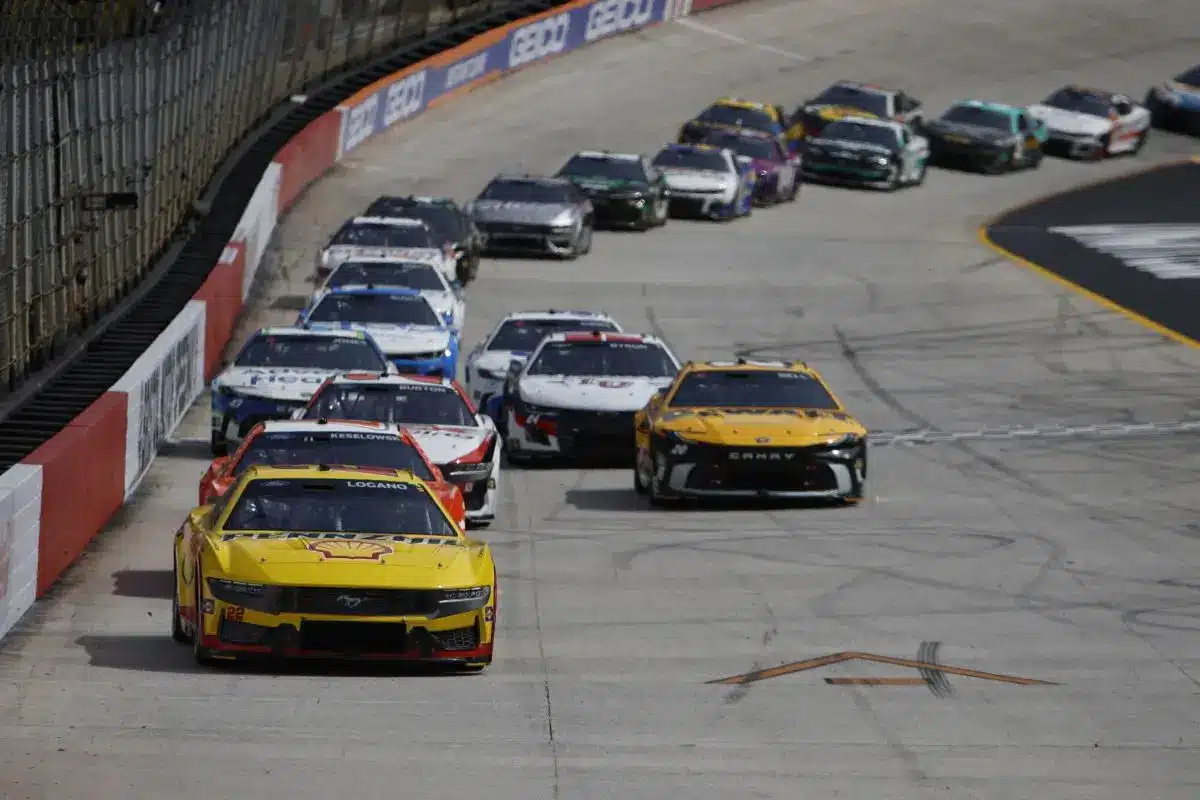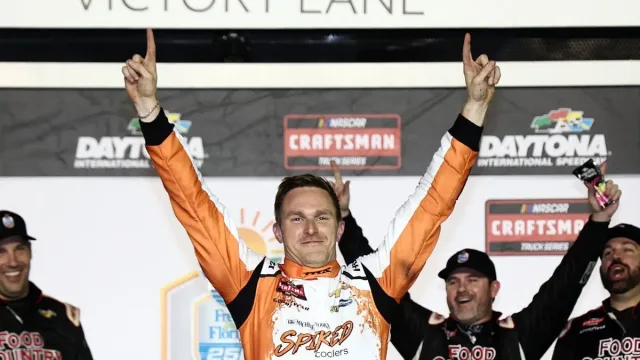Parker Kligerman’s partner blames NASCAR officials after a controversial ruling changed the outcome of the Daytona race. What seemed like a clear victory for Parker Kligerman turned into a heated debate when his No. 75 truck failed post-race inspection. NASCAR’s decision handed the win to Corey Heim, sparking frustration from Kligerman’s team. Crew chief Chris Carrier strongly opposed the ruling, arguing that a miscommunication led to an unfair penalty. The dispute has raised serious questions about NASCAR’s inspection process.
Key Highlights
- Parker Kligerman’s truck was disqualified after post-race inspection, leading to Corey Heim being awarded the victory.
- Crew chief Chris Carrier criticized the disqualification, claiming procedural missteps during the inspection process.
- NASCAR’s National Motorsports Appeals Panel upheld the disqualification, stressing compliance with stringent inspection standards.
- Kligerman expressed concerns about the lack of crew chief presence during inspections and misunderstandings of measurement procedures.
- The incident prompted discussions on improving communication and guidelines within NASCAR’s inspection process for enhanced integrity.
The Controversial Disqualification
Although Parker Kligerman celebrated what appeared to be a resounding victory at Daytona, the aftermath revealed a remarkable controversy surrounding his disqualification.
Following the race, NASCAR officials conducted a post-race inspection that resulted in the disqualification of Kligerman’s No. 75 truck, abruptly transferring the win to Corey Heim. This decision, announced within an hour of the race’s resolution, ignited a heated debate regarding the integrity of the inspection process.
Crew chief Chris Carrier expressed strong disagreement with the ruling, asserting that a procedural misstep during the inspection unfairly penalized the team.
The incident has prompted scrutiny of NASCAR’s inspection protocols, raising questions about their consistency and transparency, thereby placing the regulatory framework under considerable examination amidst the competitive atmosphere of the Truck Series.
 Cup Series Driver Passes Away at 86 2″ width=”1200″ height=”800″ srcset=”https://slicksandsticks.com/wp-content/uploads/2024/09/Daniel-Suarezs-Clash-with-Erik-Jones-1.webp 1200w, https://slicksandsticks.com/wp-content/uploads/2024/09/Daniel-Suarezs-Clash-with-Erik-Jones-1-300×200.webp 300w, https://slicksandsticks.com/wp-content/uploads/2024/09/Daniel-Suarezs-Clash-with-Erik-Jones-1-1024×683.webp 1024w, https://slicksandsticks.com/wp-content/uploads/2024/09/Daniel-Suarezs-Clash-with-Erik-Jones-1-768×512.webp 768w, https://slicksandsticks.com/wp-content/uploads/2024/09/Daniel-Suarezs-Clash-with-Erik-Jones-1-630×420.webp 630w, https://slicksandsticks.com/wp-content/uploads/2024/09/Daniel-Suarezs-Clash-with-Erik-Jones-1-150×100.webp 150w, https://slicksandsticks.com/wp-content/uploads/2024/09/Daniel-Suarezs-Clash-with-Erik-Jones-1-696×464.webp 696w, https://slicksandsticks.com/wp-content/uploads/2024/09/Daniel-Suarezs-Clash-with-Erik-Jones-1-1068×712.webp 1068w” sizes=”auto, (max-width: 1200px) 100vw, 1200px” />
Cup Series Driver Passes Away at 86 2″ width=”1200″ height=”800″ srcset=”https://slicksandsticks.com/wp-content/uploads/2024/09/Daniel-Suarezs-Clash-with-Erik-Jones-1.webp 1200w, https://slicksandsticks.com/wp-content/uploads/2024/09/Daniel-Suarezs-Clash-with-Erik-Jones-1-300×200.webp 300w, https://slicksandsticks.com/wp-content/uploads/2024/09/Daniel-Suarezs-Clash-with-Erik-Jones-1-1024×683.webp 1024w, https://slicksandsticks.com/wp-content/uploads/2024/09/Daniel-Suarezs-Clash-with-Erik-Jones-1-768×512.webp 768w, https://slicksandsticks.com/wp-content/uploads/2024/09/Daniel-Suarezs-Clash-with-Erik-Jones-1-630×420.webp 630w, https://slicksandsticks.com/wp-content/uploads/2024/09/Daniel-Suarezs-Clash-with-Erik-Jones-1-150×100.webp 150w, https://slicksandsticks.com/wp-content/uploads/2024/09/Daniel-Suarezs-Clash-with-Erik-Jones-1-696×464.webp 696w, https://slicksandsticks.com/wp-content/uploads/2024/09/Daniel-Suarezs-Clash-with-Erik-Jones-1-1068×712.webp 1068w” sizes=”auto, (max-width: 1200px) 100vw, 1200px” />
Chris Carrier’s Strong Response
Chris Carrier, the crew chief for Parker Kligerman, firmly voiced his discontent regarding the disqualification that stripped their team of the Daytona victory.
He asserted that the team adhered to all regulations, emphasizing that no illegal parts were utilized. Instead, Carrier contended that the truck was improperly measured during the inspection process, which he claimed strayed from protocols applied to other teams.
A Statement from Our Crew Chief, Chris Carrier, Regarding Our Disqualification from Daytona. pic.twitter.com/WZFmKe88VI
— Henderson Motorsports (@HendersonTrucks) February 25, 2025
“In our minds, we won this race — fair and square,” he stated, highlighting the integrity of their performance.
“There were no illegal parts, and we never stepped outside the rules. No matter what, we take pride and joy in what we achieved. We believe the post-race failure resulted from a misunderstanding between two NASCAR inspectors and our team, which led to our road crew to follow incorrect instructions on the height sticks process. There was no malicious intent; however, we firmly believe our truck was not measured correctly and was not held to the same post-race inspection procedures as the other trucks.”
“Due to this miscommunication, our front end measured an inch higher than necessary to clear heights, which in turn lowered our rear end below its minimum clearance — resulting in the disqualification. Had our truck been inspected the same way as everyone else’s, it would have passed.” – Chris Carrier
Carrier attributed the disqualification to a miscommunication between NASCAR inspectors and his team, which he argued led to the erroneous handling of the height measurement, ultimately resulting in an unjust ruling against them.
NASCAR Upholds the Ruling
Following the disqualification of Parker Kligerman’s Daytona win, NASCAR’s National Motorsports Appeals Panel confirmed that the ruling would stand, despite the team’s protests.
The panel’s decision highlighted that a violation had indeed occurred, citing Rule 10.5.2.4, which dictates disqualification for failing post-race inspection.
This ruling emphasizes the stringent compliance standards NASCAR enforces to maintain the integrity of competition, leaving no room for ambiguity.
Henderson Motorsports’ appeal was denied, effectively concluding the matter and leaving Kligerman and his team without recourse.
This situation has sparked discussions regarding the inspection process and its implications for teams, revealing the challenges inherent in balancing competitive performance with regulatory adherence in the highly scrutinized arena of professional racing.

Parker Kligerman Speaks Out
Parker Kligerman expressed his concerns about the disqualification process during a recent episode of his podcast, The Money Lap. He criticized the absence of a crew chief during inspections, emphasizing that this lack of requirement disproportionately affects smaller teams like Henderson Motorsports.
Kligerman articulated his frustration over the misunderstanding of the revised height measurement procedure introduced in 2023, which led to his team setting the front end incorrectly.
“We went to Victory Lane, went to the Media Canter, Chris was asked to come to the Media Center, my crew chief, he is the only full-time employee at Henderson Motorsports, and during this time the truck went through tech, and this is where it gets interesting,”
“I was like ‘the crew chief wasn’t there’, and that’s another thing you find out, you don’t need to have the crew chief there to go through tech – which is something I will be requesting that NASCAR investigate that because it’s kind of crazy, especially on the smaller teams, to not have a person of authority there when the car/truck is going through tech, really is a tough thing to swallow.” – Parker Kligerman
He outlined three key points:
- The necessity of having crew chiefs present during inspections to guarantee fair competition.
- The impact of procedural changes on smaller teams’ performance.
- The need for clearer communication regarding rule modifications to prevent future discrepancies.
Looking Ahead: Lessons Learned
As the dust settles on the disqualification incident, there are noteworthy lessons to be drawn for both Kligerman and the broader NASCAR community.
Kligerman and his team, led by Carrier, have acknowledged the necessity of a deeper understanding of procedural regulations, emphasizing the importance of compliance in a highly competitive environment.
“What we’ve now discovered, is that when you set and measure the front end then you can no longer touch it once it goes on the height sticks, so you have to hope it’s correct, and what happened with our team was because Chris wasn’t there, and there was no person of authority, our mechanics have all said they were told to unhook the shocks and lift the front end up, which is not the procedure.”
“That’s where it was a communication error.”
”It was a lack of knowledge on our part, of course, on how this happens or how this process is done and that’s why when I say that this truck was legal when it raced, yes, it was, and it would have been legal had it been given the chance to set the front end properly – yeah, follow the procedure, we just didn’t follow the procedure.” – Parker Kligerman
While Kligerman retains the winning flag and cherishes the performance, the incident highlights the scrutiny that smaller teams face in post-race inspections.
This disqualification has ignited a critical dialogue regarding the inspection process, advocating for clearer guidelines to help teams navigate the complexities of regulations.
Ultimately, a more informed NASCAR community will bolster the integrity of the sport while ensuring all teams are equipped to compete fairly and effectively.

News In Brief: Parker Kligerman’s Partner Blames NASCAR Officials
The disqualification of Parker Kligerman from his Daytona win has sparked intense scrutiny of NASCAR’s inspection process, highlighting the need for transparency and consistency in enforcing regulations. Carrier’s firm response and NASCAR’s decision to uphold the ruling underline the seriousness of compliance within the sport.
Kligerman’s comments reflect a commitment to integrity, emphasizing the importance of learning from this incident. Moving forward, the NASCAR community must prioritize strict adherence to rules to maintain fairness and trust among competitors.
ALSO READ: Parker Kligerman Opens Up on Losing Daytona DQ Appeal and Refuses to Stay Silent
